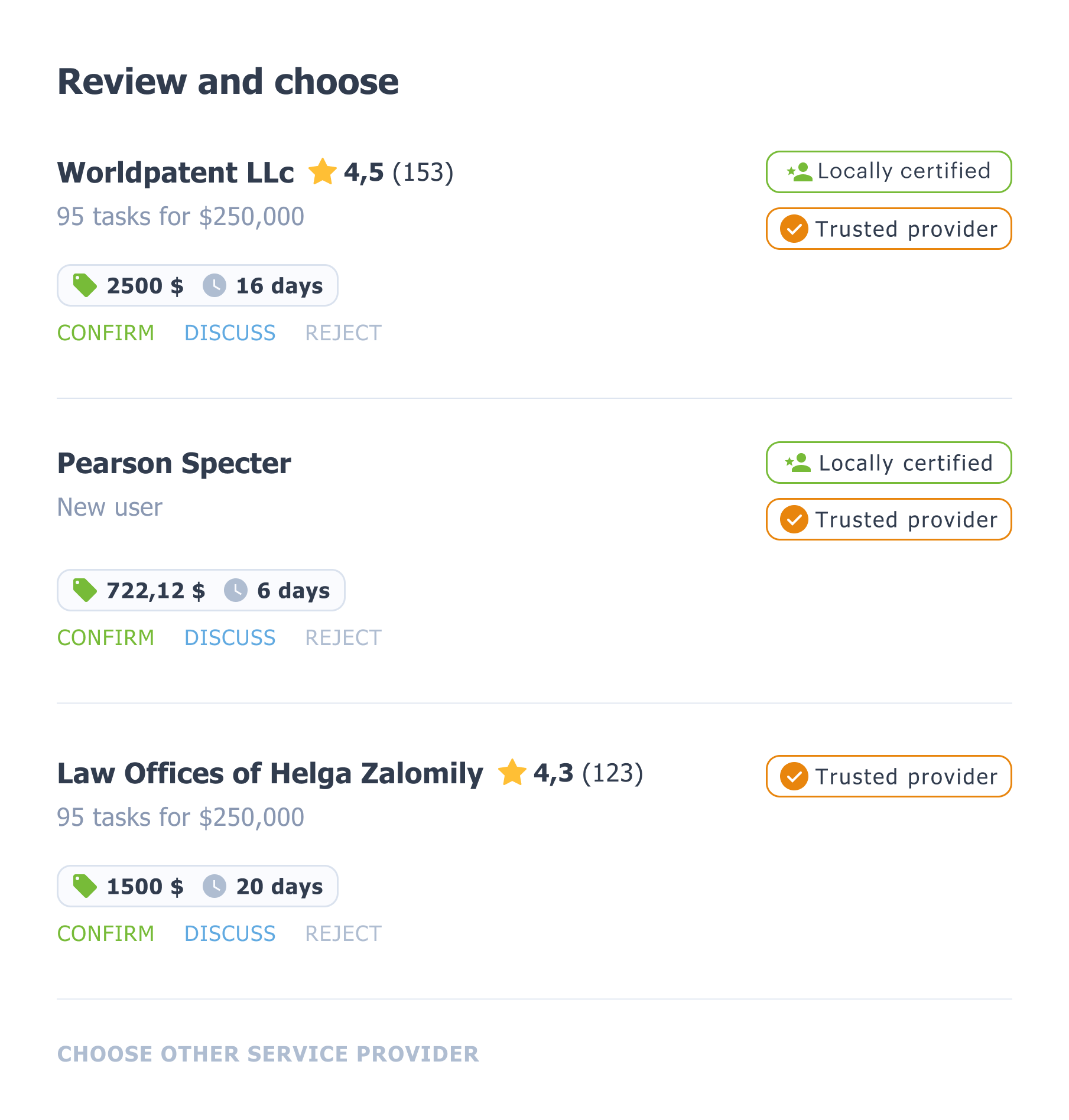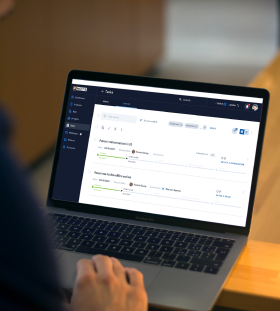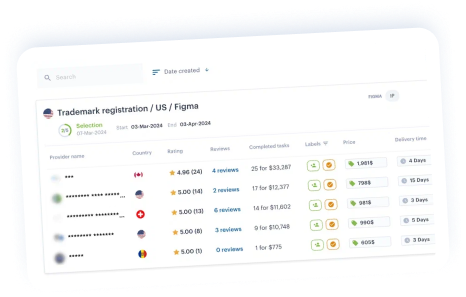البحث عن قابلية الحصول على براءة اختراع في هونغ كونغ
ابحث في قواعد بيانات براءات الاختراع، وحدد التضاربات المحتملة، وتحقق من تفرد البراءات. تُتيح هذه المرحلة طريقة آمنة للبحث والتطوير، مما يُساعد على تجنب المشاكل القانونية.



ابحث في قواعد بيانات براءات الاختراع، وحدد التضاربات المحتملة، وتحقق من تفرد البراءات. تُتيح هذه المرحلة طريقة آمنة للبحث والتطوير، مما يُساعد على تجنب المشاكل القانونية.







-
مساعد IP مدعوم بالذكاء الاصطناعي يساعدك على إنشاء مهمة مفصلة خلال دقائق.
-
اختيار وكيل براءات الاختراع المحلي الأكثر ملاءمة بناءً على معايير محددة.
-
إجراء بحث من خلال قواعد بيانات براءات الاختراع، وتحديد الصراعات المحتملة وتحديد الاستراتيجية.
-
المراقبة عبر الإنترنت وإعداد التقارير على المنصة طوال العملية بأكملها.

-

أكثر من 800 شركة محاماة متخصصة في الملكية الفكرية من أكثر من 150 دولة، تصنيف ومراجعات
-

مساعد IP مدعوم بالذكاء الاصطناعي يساعد في إنشاء المهام والعثور على المحامين ذوي الصلة
-

رسوم ثابتة، ومدفوعات آمنة وسريعة عبر الإنترنت مع نتائج مضمونة
-

إمكانية الوصول إلى عملية التسجيل وتخزين البيانات عبر الإنترنت لجميع حالاتك على مدار الساعة طوال أيام الأسبوع









































فهم البحث عن قابلية براءات الاختراع في هونغ كونغ: دليل استراتيجي
عند التفكير في تسجيل حقوق الملكية الفكرية، يُعدّ البحث عن براءة اختراع من أهم الخطوات المبكرة. تساعد هذه العملية المبتكرين على تحديد ما إذا كان اختراعهم جديدًا وغير بديهي مقارنةً بالتقنيات الحالية. يزيد الفحص الدقيق من فرص نجاح عملية التسجيل، ويوفر وقتًا ثمينًا، ويجنّب التكاليف غير الضرورية. في بيئة تنافسية واعية بالملكية الفكرية، تُعد هذه الخطوة الاستراتيجية بالغة الأهمية لأي شركة تخطط لطرح منتجات أو حلول جديدة في السوق.
لماذا يُعد البحث عن قابلية براءة الاختراع أمرًا مهمًا
يُقيّم تقييم الجدة تفرد وأصالة الفكرة أو الحل التقني. يتضمن ذلك مراجعة قواعد البيانات وسجلات الابتكار لتحديد الأعمال السابقة - أي التطورات أو المنشورات الحالية التي قد تؤثر على إمكانية التسجيل.
في هونغ كونغ، حيث يتوافق الإطار القانوني بشكل وثيق مع المعايير الدولية، قد يؤدي عدم إجراء تحقيق شامل إلى رفض مكلف. بالنسبة لرواد الأعمال والباحثين والشركات، لا تُعدّ هذه الخطوة المبكرة مجرد ممارسة فعّالة، بل تُعدّ أيضًا وسيلةً للحد من المخاطر القانونية والمالية.
الأهداف الرئيسية لمثل هذه المراجعة:
- التحقق مما إذا كان المفهوم الفني قد تم الكشف عنه بالفعل
- فهم مستوى الحماية التي قد يتم منحها
- تجنب التداخل مع الحقوق الحصرية الموجودة
- إبلاغ استراتيجيات التقديم، بما في ذلك ما إذا كان ينبغي المضي قدمًا في تقديم طلب مؤقت أو قياسي
أنواع طلبات براءات الاختراع
قبل الخوض أكثر في البحث، من الضروري فهم أنواع الحماية المتاحة:
1. المعيار (O)يتطلب هذا المسار التقديم أولاً في مكاتب براءات الاختراع المُعتمدة (مثل الصين، المملكة المتحدة، المكتب الأوروبي لبراءات الاختراع)، ثم التسجيل. وهو يوفر حماية طويلة الأمد.
2. قياسي (R):تم تقديم هذا المسار في ديسمبر 2019، وهو يسمح بالتقديم والفحص المباشر من قبل إدارة الملكية الفكرية المحلية (IPD).
3. الحماية قصيرة المدى:يوفر حقوقًا أسرع وأبسط للابتكارات ذات العمر التجاري الأقصر.
يؤثر نوع التسجيل الذي تخطط لمتابعته على نطاق وعمق عملية المراجعة.
كيفية إجراء بحث عن قابلية براءة اختراع في هونغ كونغ
لتحقيق نتائج ملموسة، اتبع نهجًا منظمًا. فتعقيدات العناية الواجبة بالملكية الفكرية غالبًا ما تتطلب فهمًا فنيًا وخبرة قانونية.
الخطوات الرئيسية:
1. حدد الاختراع بدقة
2. تحديد الكلمات الرئيسية والمصطلحات التقنية ذات الصلة
3. استخدام الأدوات العالمية والمحلية لمراجعة الإفصاحات الحالية
4. تقييم الحلول التقنية والمنشورات المماثلة
5. استشر محاميًا مؤهلًا في مجال الملكية الفكرية
مع أن بعض الأدوات متاحة عبر الإنترنت، إلا أن التوجيه المحلي بالغ الأهمية. ستفهم شركات الاستشارات أو المتخصصين ذوي السمعة الطيبة في مجال الملكية الفكرية الفروق الدقيقة الإقليمية والتفاصيل الإجرائية الدقيقة. حتى بالنسبة للشركات التي لديها فرق بحث وتطوير داخلية، يُنصح بالتحقق الخارجي.
أدوات وموارد للبحث عن براءات الاختراع
يضمن استكشاف قواعد بيانات متعددة نتائج أكثر موثوقية. تشمل الموارد الرئيسية ما يلي:
- شبكة إسبيسنت
- CNIPA (لبيانات الملكية الفكرية الصينية)
- مكتب براءات الاختراع والعلامات التجارية الأمريكي (للسجلات الأمريكية)
- ركن براءات الاختراع للويبو
- نظام تسجيل IPD في هونغ كونغ
إن الاستعانة بخبير قانوني محلي قد يساعد في الكشف عن إفصاحات سابقة أقل وضوحًا، وخاصة في المستندات غير المكتوبة باللغة الإنجليزية أو الملفات الخاصة بالمنطقة.
متى يجب عليك إجراء بحث حول قابلية الحصول على براءة اختراع؟
التوقيت مهم. ينبغي إجراء تقييم قبل صياغة أي طلب وتقديمه، خاصةً إذا كانت شركتك تفكر في دخول أسواق متعددة أو تطوير محفظة أوسع من الملكية الفكرية. ويزداد هذا الأمر أهمية عند تقديم طلب التقديم الأولي، إذ يُحدد تاريخًا مبكرًا للتقديم يتطلب إضفاء الطابع الرسمي عليه لاحقًا.
من الذي ينبغي أن يقوم بالبحث؟
بينما يمكن للمخترعين بدء التحقيقات الأولية بأنفسهم، يضمن مقدم الخدمة المحترف إجراء تحليل أكثر تعمقًا. ولا سيما في حالة التطورات التقنية عالية القيمة أو تلك التي تُنفذ في قطاعات تنافسية مثل التكنولوجيا الحيوية، والتكنولوجيا المالية، والإلكترونيات، فإن المساعدة المتخصصة ضرورية.
فوائد استخدام خدمة المراجعة المهنية:
- إمكانية وصول أوسع إلى قواعد البيانات الدولية والإقليمية
- التفسير الفني والقانوني للنتائج
- التوجيه الاستراتيجي بناءً على الإفصاحات الحالية
- رؤى فعّالة من حيث الوقت والتكلفة
قائمة التحقق للبحث الناجح عن براءة اختراع
استخدم قائمة المراجعة البسيطة هذه لتوجيه تحضيراتك:
- حدد المفهوم الفني بوضوح
- اختر المصطلحات ذات الصلة والمصطلحات الصناعية
- استكشاف مصادر البيانات المختلفة (ابدأ بالبحث عن براءات الاختراع)
- مراجعة كل من السجلات المنشورة والملفات المعلقة
- احتفظ بسجل للنتائج والمراجع الرئيسية
- مناقشة النتائج مع متخصص في الملكية الفكرية
- استخدم النتائج لتشكيل استراتيجية التقديم الخاصة بك
خاتمة
تُعدّ المراجعة السليمة للملكية الفكرية أساس أي استراتيجية ابتكار فعّالة في هونغ كونغ. فهي تُوفّر الوضوح والتوجيه والثقة قبل دخول المجال القانوني والتجاري. بالاستثمار في عملية مراجعة مدروسة - بدعم من شركة موثوقة أو متخصص قانوني - يُمكن للشركات والأفراد تعزيز مكانتهم في السوق. سواءً كانوا يسعون إلى حماية قصيرة الأجل أو تسويق طويل الأجل، فإن البدء بدراسة دقيقة للفن السابق يُعدّ خطوة ذكية واستباقية.




